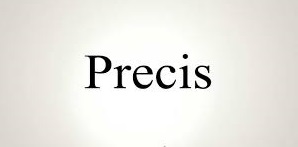How To Write A Good Precis-For W.B.C.S Main Examination.
WBCS পরীক্ষার জন্য – কীভাবে একটি ভাল প্রিসিস লিখতে হয়।
Derived from French, the word “précis” means a summary. So, if your professors give you such writing assignments, they want you to summarize some text and convey the summary in minimum words.Continue Reading How To Write A Good Precis-For W.B.C.S Main Examination.
- A critical précis is a clear, concise, and logical summary of a passage preserving its essential ideas only.
Before writing a précis, make sure you clearly understand its peculiarities and specification.
The first and foremost:
A précis is NOT an essay or re-writing. It shouldn’t tell but summarize a core essence of the original document and provide readers with the information about its significance and worth.
In other words:
Even if your audience didn’t read the original abstract, they should have a clear idea about its content and meaning after checking your précis. A précis explains the main point and structure of the original work but doesn’t offer any evaluations or your personal reactions.
A Critical Précis Characteristics
When assigned to write a critical précis, make sure you understand its characteristics which are:
- A précis is a critical summary of writing abstracts.
- A précis is NOT re-writing or interpretation of the original.
- It is NOT written with words from the original, though you are welcome to use some quotes if appropriate.
- It summarizes the content of the original.
- A précis reveals a meaning of the original and explains its value.
- As a rule, a précis is 1/4 of the original in length, except as noted.
- It follows the standard format: an author’s thesis and methods he uses to represent it, results, and conclusion.
A Critical Précis Qualities
A précis will demonstrate your writing skills to professors, as well as your ability to express your thoughts intelligibly. Make sure your paper highlights the following qualities:
- Clarity, which means your reader should understand what a writer intended to convey. Achieve it through using simple language and structure of your precis.
- Correctness, which means you should watch spelling, grammar, and punctuation you use, as well as facts, figures, and dates you address.
- Objectivity, which means candid construal of the information. Don’t give your opinion in a précis.
- Coherence, which means the logical interconnection of the original’s ideas. Your audience shouldn’t lose their interest while reading.
- Conciseness, which means avoiding unnecessary details in your précis. Don’t omit essential facts but avoid wordy expressions, repetitions, wateriness, etc.
How to Write A Good Précis
One of the most famous American essayists, Mr. Twain nailed it: short doesn’t equal quick and easy to write, especially if you write a summary, not simple re-writing of the original. So, the process of writing a précis starts with critical reading and research:
- Read the original piece carefully.
- Specify its main points and arguments.
- Consider the evidence used by the author.
- Research unfamiliar material (definitions, statements, unknown words, data, etc.)
- Identify the appeals used by the writer.
- Evaluate how the author conveyed meaning.
- Restate the thesis.
- Write a 1-2 sentence summary of each section of the article.
- Describe the piece in your own words.
- Reread the article and compare it with your summary.
Some Sample Precis Are Given Below-
Sample 1
In her article “Who Cares if Johnny Can’t Read?” (1997), Larissa MacFarquhar asserts that Americans are reading more than ever despite claims to the contrary and that it is time to reconsider why we value reading so much, especially certain kinds of “high culture” reading. MacFarquhar supports her claims about American reading habits with facts and statistics that compare past and present reading practices, and she challenges common assumptions by raising questions about reading’s intrinsic value. Her purpose is to dispel certain myths about reading in order to raise new and more important questions about the value of reading and other media in our culture. She seems to have a young, hip, somewhat irreverent audience in mind because her tome is sarcastic, and she suggests that the ides she opposes are old-fashioned positions.
Sample 2
In her essay “Cyberspace and Identity” (1999), Sherry Turkle argues that “today’s life on the screen dramatizes and concretizes a range of cultural trends that encourage us to think of identity in terms of multiplicity and flexibility” (272). Turkle supports her assertion by juxtaposing theories of cyberspace and identity formation with older understandings of identity found in psychology, sociology, and philosophy. Her purpose is to show readers that theories on cyberspace and identity, which claim that identity is multiple and cyclical, do not overturn, but rather add to our understandings of identity in order to encourage her audience “to rethink our relationship to the computer culture and psychoanalytic culture as proudly held joint citizenship”. Turkle’s tone assumes a highly educated audience who is familiar with theories not only of cyberspace and identity, but sociology and psychology as well.
Sample 3
Charles S. Peirce’s article “The Fixation of Belief” (1877) asserts that humans have psychological and social mechanisms designed to protect and cement (or “fix”) our beliefs. Peirce backs this claim up with descriptions of four methods of fixing belief, pointing out the effectiveness and potential weaknesses of each method. Peirce’s purpose is to point out the ways that people commonly establish their belief systems in order to jolt the awareness of the reader into considering how their own belief system may the product of such methods and to consider what Peirce calls “the method of science” as a progressive alternative to the other three. Given the technical language used in the article, Peirce is writing to a well-educated audience with some knowledge of philosophy and history and a willingness to consider other ways of thinking.
Our own publications are available at our webstore (click here).
For Guidance of WBCS (Exe.) Etc. Preliminary , Main Exam and Interview, Study Mat, Mock Test, Guided by WBCS Gr A Officers , Online and Classroom, Call 9674493673, or mail us at – mailus@wbcsmadeeasy.in
Visit our you tube channel WBCSMadeEasy™ You tube Channel
Please subscribe here to get all future updates on this post/page/category/website



 +919674493673
+919674493673  mailus@wbcsmadeeasy.in
mailus@wbcsmadeeasy.in






































































































